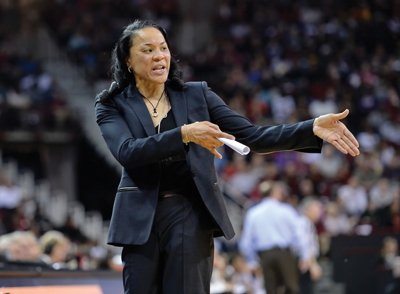We are now getting immersed in March Madness and all the excitement of college basketball, but a new report has to temper the joy.
The recently issued 2014 College Sport Racial and Gender Report Card is filled with terrible news based on the statistics.
The report card was released as the nation focused on racism during the 50th anniversary of Bloody Sunday and the March on Selma; as Facebook COO Sheryl Sandberg and the NBA partnered to get men and women to work together for gender equity; and as the Justice Department released its finding of racism in the Ferguson, Mo., police force. Those weighed heavily on the nation’s consciousness, but for sports fans, the college report card should be sobering and deeply disturbing as well.
The report card was by far the worst issued among all professional leagues and the colleges in the past year.
College sports received a C+ for racial hiring practices, a C- for gender hiring, and a combined grade of C. All were down from the 2013 report card — from a B, C+ and C+, respectively. The drop in the race and gender grades emphasized an area of continuing and alarming concern. College sports continued to have the lowest grade for racial hiring practices and is now tied with the NFL for the lowest grade for gender hiring practices among all of the college and professional sports.
Back to March Madness. The report card was especially bad news regarding the opportunity for people of color among men’s and women’s basketball head coaches, where the percentages declined again. For the 2013-14 season, 22 percent of the men’s Division I basketball coaches were African-American (down from 23 percent) and 23.8 percent were coaches of color (down from 24.8 percent). The all-time high was in 2005-06, when 25.2 percent of all the head coaches were African-American and 26.2 percent were people of color. The all-time low was during the 2011-12 season, when 18.6 percent were African-American and 19.5 percent were coaches of color. After much scrutiny was placed on the sport, the 2012-13 season witnessed an impressive gain of 4.4 percentage points among head coaches of color. However, the 2013-14 season saw another lapse.
 |
South Carolina’s Dawn Staley is among the 10.6 percent of African-American women who were coaching NCAA Division I women’s basketball teams during the 2013-14 season.
Photo by: AP IMAGES
|
For Division I women’s basketball in the 2013-14 season, African-American women head coaches held 10.6 percent of the positions and African-American men held 3.7 percent of the positions for a combined percentage of 14.3 percent, a significant decrease from the 20.6 percent reported in 2012-13.
The bad news was hardly limited to basketball.
The number of head football coaches of color at the FBS level decreased from 15 in the 2013 report to 14 at the start of the 2014 season. Nearly 89 percent were white. The number recently had been as high as 18.
Whites continued to dominate the head coaching ranks on men’s and women’s teams in all three divisions, holding between 85 percent and 91 percent of all head coaching positions, respectively.
Arguably the worst records are for gender hiring practices.
The report card includes a gender grade for all Division I head coaches for men’s teams and Division I head men’s basketball coaches in response to feedback on our reports from scholar and activist Molly Arenberg.
While it has been common practice for men to coach women’s teams, it is rare for a woman to coach a men’s team. Men are head coaches on more than 60 percent of women’s teams across all three divisions combined. Women held only 38.2 percent of the head coaching jobs of women’s teams in Division I, 34.8 percent in Division II and 43.9 percent in Division III.
Men hold more than 50 percent of the assistant coaching positions on women’s teams across all three divisions combined. Women held only 47 percent, 48.5 percent and 51.2 percent of assistant coaching positions of women’s teams in Divisions I, II, and III, respectively.
Whites held the overwhelming percentage of athletic director positions during the 2013-14 year at 87.7 percent, 91.5 percent and 94.5 percent in Divisions I, II, and III, respectively. Women made up only 9.6 percent of Division I athletic directors.
All FBS conference commissioners were white men in 2014. Looking at all Division I conferences, excluding historically black conferences, 29 of 30 commissioners were white.
All of these figures stand in stark contrast to our student-athlete population numbers, where African-American men made up 25 percent of the total in Division I in 2013-14. African-American women made up 15 percent in 2013-14.
The records for coaches, athletic directors and conference commissioners have been completely unacceptable. Now, in 2015, they are intolerable.
The greatest number of career prospects are in college sports rather than professional sports because of the number of jobs available. That makes it even more important for us to create expanded opportunities in college sports for women and people of color.
Richard E. Lapchick (rlapchick@ucf.edu) is the director of the Institute for Diversity and Ethics in Sport at the University of Central Florida, which annually publishes racial and gender report cards on MLB, the NBA and WNBA, NFL, MLS, college sports, and the APSE. He is also chairman of the DeVos Sport Business Management Program. Follow him on Twitter @richardlapchick.





